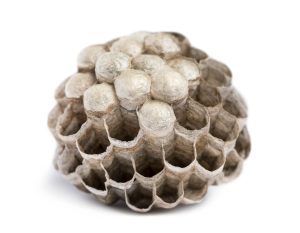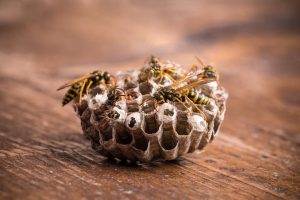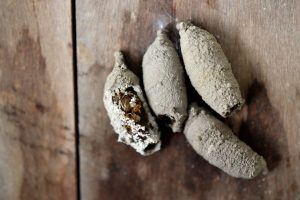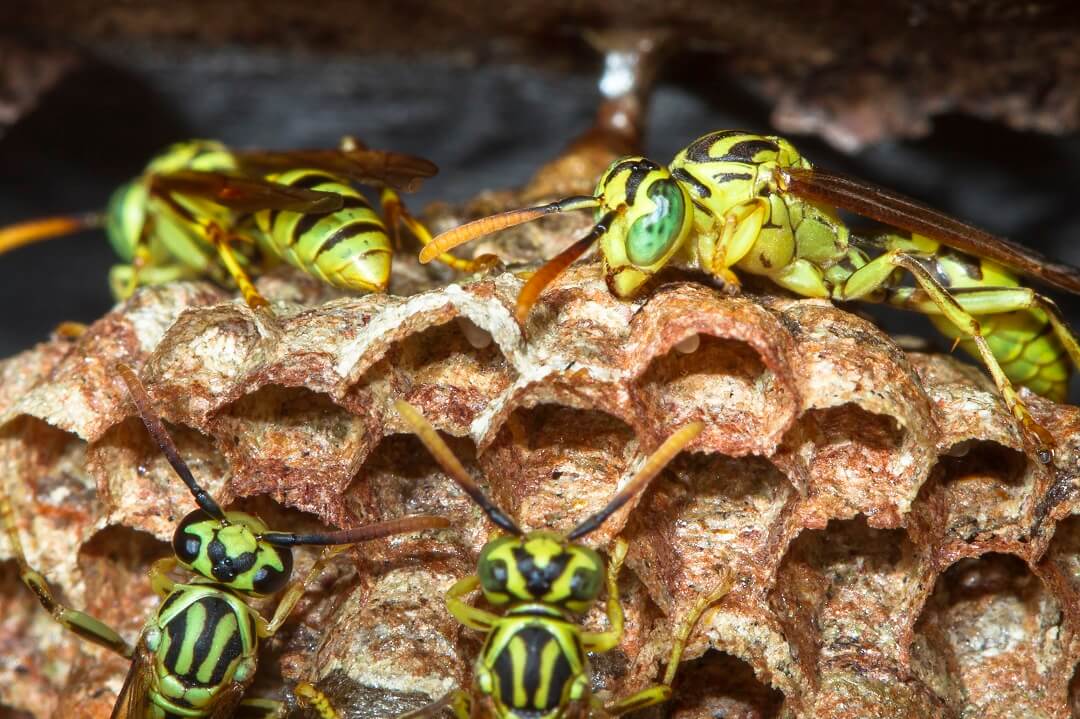As the spring season approaches, you may notice an increase in buzzing insects, including wasps. While Southern California can experience wasp problems year-round due to our climate, most wasp nests only last a summer season, with the colony dying off in the winter. During the end of winter and into early spring, wasp activity takes shape as the mated queen emerges and begins creating a new wasp nest. What each wasp nest looks like, however, depends on the type of wasp you have in your area and can range from paper-like balloon nests hanging from eaves to mud-like nests built on ceilings or walls.
Key takeaways
- Wasps tend to live for only one season, though in Southern California, wasp colonies can survive through winter and lead to very large colonies.
- A single, mated queen begins nest construction in the early spring with a single center stalk where she will lay eggs. The nest continues to grow through the spring and summer months as the colony grows, with construction being taken over by other members of the colony.
- Wasp nests can grow to the size of a football or basketball, especially when it is a paper wasp colony.
- Removing an established wasp nest can be dangerous and is best left to professional pest control specialists as the wasps often become aggressive when defending their home, increasing the risk of multiple stings.
Identifying a wasp nest
Identifying a wasp nest is relatively easy. However, determining the type of wasp creating the nest varies depending on the size of the nest, its overall appearance, and its location. In Southern California, there are many different wasp species, with the most common being the yellow jacket, paper wasp, mud dauber, and bald-faced hornet, which is actually not a true hornet but a species of wasp.
What is the difference between a wasp and a hornet’s nest?
True hornets are actually a subset of wasps, so in many ways, they are very similar. True hornets, however, are not found in Southern California, with the only true hornets being the European hornet found in the Eastern U.S. and the Asian Giant Hornet, recently discovered in Washington state. Most hornets make nests from a combination of saliva and chewed wood pulp, the same as a wasp, but certain species of hornets, such as the Asian Giant Hornet, can live underground in subterranean nests similar to yellow jacket wasps.
Types of wasp nests
When identifying wasp nests, it is important to understand the different types of wasps and how and where they build their nests. Here we look at the four common wasp nests you may find in Southern California.

Yellowjackets
Yellow jackets are the most common wasp variety and are also very aggressive. They will sting when they feel their nest is threatened but will also sting unprovoked. Yellow jacket nests are often found within cracks in your garage, shed, and even walls, making them much more difficult to discover. In some cases, yellow jackets will build their nests underground, such as in rodent burrows. A new nest is created every spring and can reach populations of up to 15,000 wasps by the end of the season, depending on the specific species of yellow jacket. The yellow jacket nest is created with multiple tiers of vertical cells made from wood mixed with saliva, with the single nest entrance covered by a paper envelope.

Paper wasps
Paper wasps create their nests in protected areas, such as under eaves, in attics, or underneath large tree branches. A paper wasp nest resembles an upside-down umbrella with open cells exposed. In many cases, you may be able to see white grub-like larvae within each cell. A typical paper wasp nest can house up to 200 wasps. While not typically aggressive, paper wasps will defend their nest when they feel threatened.

Bald-faced hornets
Baled-faced hornets are known for building large, often basketball-shaped nests with a single entrance hole at the bottom of the nest. These nests are usually found at least three feet from the ground, attached to trees, shrubs, or even patio ceilings. They have a thick, multi-layered shell around the outside that holds two to four horizontal comb cells inside. While large in size, these nests only house 100-700 workers.

Mud daubers
Mud daubers are solitary wasps, meaning they do not live in colonies. They build small nests made of hard mud and are found in cracks and crevices in the exterior walls of your home or shed. A single female wasp attends these nests. Mud daubers do not defend their nests and rarely sting. During the winter months, these abandoned nests can be easily removed.
How are wasp nests made?
Wasp nests typically start out small as the queen builds a nest only large enough to support the initial eggs she lays. The queen finds a suitable location and begins stripping wood to turn it into a paper mache-like paste. She creates a center stalk in a secure and dry location and slowly adds papery cells to the center stalk. At this small size, nests can often be dislodged and removed before the population continues to grow. As the eggs begin to hatch and worker bees become active, they continue the building process, creating many more cells for the queen to continue laying eggs, increasing the population.
How to find wasp nests
Finding a wasp nest will also depend on the type of nest construction. While checking trees in your yard, as well as overhangs, eaves, window sills, and inside garden sheds allows you to quickly locate hanging nests from a yellow jacket, paper wasp, or baled-faced hornet, finding nests made within the ground can often be difficult. Ground nests often show nothing more than a hole in the ground or a small pile of dirt with a smaller entrance hole. Spending time outdoors and watching will often reveal the location of an underground nest as wasps enter and leave.
What to do when you find a wasp nest?
If you discover a nest in the early stages, when it is the size of a golf ball or smaller, you can easily dislodge the nest with a stick or broom and dispose of it. However, as the nest grows and the wasp population increases, disposing of the nest can become dangerous and put you at risk of multiple wasp stings. If you discover a large wasp nest, it is best to bring in professional pest control experts.
Addressing a wasp nest requires great care.
If you discover a wasp nest in your yard or attached to your home, there are some things to consider. If the wasps are not causing a problem, their presence can be beneficial as they help control other insect pests in your yard and home. If, however, you are experiencing wasp swarms in your yard or have small children or pets, addressing the nest may be necessary. If you catch a nest in the early stages, you can easily remove the nest and hope any surviving wasps move on to other areas. However, addressing a large wasp nest can be dangerous and put you at risk for multiple wasp stings. In these cases, it is recommended to bring in professional pest control experts that are trained in bee and wasp control.
Our team comes prepared to tackle even the largest wasp nests.
At Insight Pest Management, we understand how wasps, bees, and hornets can ruin any outdoor summer plans very quickly. If you are experiencing a problem with these stinging insects, have discovered a large nest, or suspect a nest nearby, our team of experts comes armed with safety gear and the tools necessary to remove these pests before they ruin any more outdoor plans.
To learn more about wasp removal and how we can help you keep your home and yard pest free, book a free quote today.


